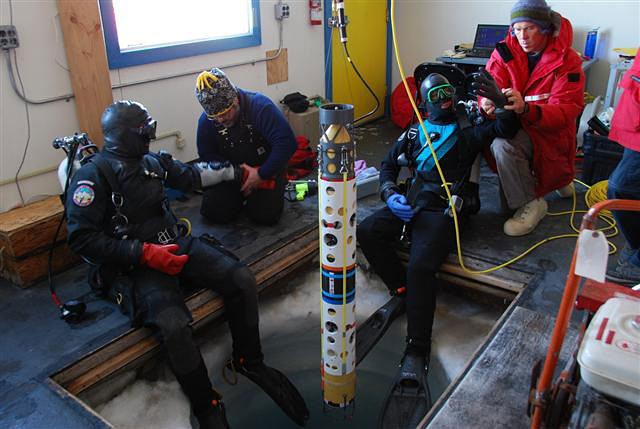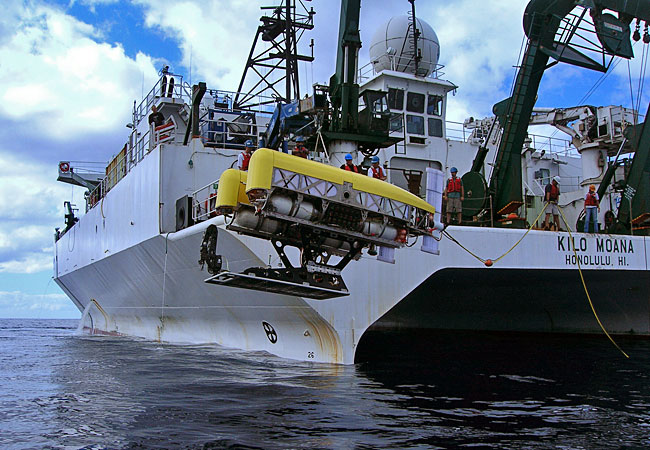On a long leashWHOI engineers to develop polar ROV capable of exploring far below ice shelvesPosted September 30, 2011
Engineers and scientists at Woods Hole Oceanographic Institution (WHOI) WHOI engineer Andrew Bowen Operating a traditional ROV — tethered to a research vessel with reinforced cable that contains copper to deliver power and fiber optics for communications and control — is far from ideal when working in extreme environments, according to Bowen. And he knows something about developing robots for extreme environments. He led a team that created Nereus It’s the latter innovation that Bowen sees as making an under-ice ROV possible. “As you go deeper and deeper into the ocean, the tether cable imposes greater and greater penalties [to operate],” he explained. “Our [polar] project is intended to address that by incorporating a nontraditional tethering technique that was pioneered by the Nereus vehicle development program. “This technique for tethering a vehicle for an extreme environment like the Mariana Trench turns out to be relevant for enabling similar kinds of operations in an ice-bound environment,” he added.” You turn the tether on its ear: Instead of operating it vertically at extreme ranges, you are capable of operating it horizontally at extreme ranges.” Extreme range in this case equates to about 20 kilometers, which could take the polar ROV far underneath an ice shelf, for example, where scientists have only stolen rare glimpses of life and oceanic processes beneath the floating chunks of ice. One of the big unknowns in climate change research is how the ocean interacts with glacial features like ice shelves, which slow the flow of ice into the ocean. Scientists believe that the faster erosion of some ice shelves by the ocean is allowing glaciers to flow faster, which ultimately increases sea level. One area of particular concern is Pine Island Bay, where scientists recently reported that stronger ocean currents beneath a small ice shelf are eroding the ice from below, which in turn is speeding the melting of the glacier that flows into it. The glacier is currently sliding into the sea at a clip of four kilometers a year, while its ice shelf is melting at about 80 cubic kilometers a year. That’s about 50 percent faster than it was melting 15 years ago. A research team, working aboard the research vessel Nathaniel B. Palmer Bowen said an autonomous underwater vehicle (AUV) does a good job of mapping but isn’t able to react outside of its pre-programmed mission like a person aboard a ship can while guiding an ROV with a joystick. “The detailed inspection of the under-ice environment is something that is still beyond the capacity of fully autonomous systems to perform because of the highly unstructured nature of the exploration mission,” he said. “Where [the polar vehicle] comes into its own is that it provides real-time information back to the researchers and gives them the ability to explore a highly unknown environment.” A different research team will attack the problem of melting in the Pine Island region this upcoming field season by drilling through the ice shelf and deploying probes into the ocean below, where researchers hope to learn more about ice-water interaction. Robert Bindschadler “The WHOI ROV is being built for a different purpose than what I’d use it for, but it advances the technology in a direction necessary to eventually build science probes for studying processes in the sub-ice-shelf environment,” said Bindschadler, who is not involved in the project. 
Photo Credit: Francois Cazenave/Antarctic Photo Library
Divers prepare to go into the water under the sea ice with SCINI.
The proposed WHOI ROV isn’t the first tethered robot designed specifically for the polar regions. Scientists and engineers from Moss Landing Marine Labs A mere 15 centimeters wide, SCINI spent three years exploring McMurdo Sound. Last year, it was dropped through the 300-meter-thick Ross Ice Shelf Bowen said he hopes the polar ROV will be ready for an Antarctic field season by 2014, with various tests of the system over the next two years in the Arctic and elsewhere. The team at WHOI, which includes engineers and scientists, is also collaborating with a Canadian defense agency that operates an AUV in the Arctic. “We’ll be working with the Canadians to learn the tradecraft of working in a polar environment,” Bowen said. The specifications for the vehicle are still in the nascent stages — and Bowen hopes to recruit an advisory committee of scientists to address the research requirements — but the polar ROV will likely adopt some of the core features of Nereus, such as the electronics and tethering system. “Think of it being the same nervous system but a different body,” Bowen said. Nereus weighs in at a hefty 2,800 kilograms, powered by a bank of rechargeable lithium ion batteries onboard the vehicle. The polar ROV will likely be smaller, since it doesn’t have to withstand the high pressure of the deep ocean like Nereus. “We’re really excited about embarking on a challenge as significant as this. All of us have the greatest respect for the polar environment, and in particular the Antarctic environment,” Bowen said. “Providing access to an under-ice environment is equal to, if not greater than the challenges inherent in building a system to go to the bottom of the Mariana Trench.”
NSF-funded research in this story: Andrew Bowen, Larry Mayer, Dana Yoerger, Chris German and James Kinsey, Woods Hole Oceanographic Institution, Award No. 1126311 |



For USAP Participants |
For The Public |
For Researchers and EducatorsContact UsU.S. National Science FoundationOffice of Polar Programs Geosciences Directorate 2415 Eisenhower Avenue, Suite W7100 Alexandria, VA 22314 Sign up for the NSF Office of Polar Programs newsletter and events. Feedback Form |




